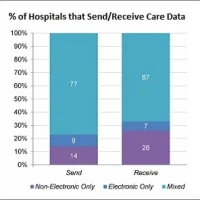Researchers at Johns Hopkins University have developed a new computer-based method that can help clinicians identify hospital patients at risk of septic shock. The method correctly predicts septic shock in 85 percent of cases, without increasing the false positive rate from screening methods that are currently used, according to a study published in the journal Science Translational Medicine.
"The critical advance our study makes is to detect these patients early enough that clinicians have time to intervene," says lead author Suchi Saria, an assistant professor of computer science and health policy at Johns Hopkins' Whiting School of Engineering. More than two-thirds of the time, she notes, the method was able to predict septic shock before any organ dysfunction. That is a 60 percent improvement over existing screening protocols.
Sepsis is caused by a powerful immune system reaction to infection that, if untreated, can cause inflammation throughout the body; the inflammation can trigger blood clots and leaking blood vessels. For a patient with sepsis — which kills more Americans every year than AIDS and breast and prostate cancer combined — hours can make the difference between life and death.
The study covered electronic health records of 16,234 patients admitted to intensive care units — including medical, surgical and cardiac units — at Boston's Beth Israel Deaconess Medical Center from 2001 to 2007. Prof. Saria and her team created an algorithm that combines 27 factors into a Targeted Real-time Early Warning Score (TREWScore) measuring the risk of septic shock.
The algorithm differs in several respects from previous attempts to predict septic shock. It is based on a larger data pool, takes account of more health indicators, and factors in several elements that could have confounded the results.
To use the TREWScore, the algorithm could be programmed into an electronic health records system to alert doctors and nurses about a patient at risk of septic shock, says co-author David Hager, who directs the Medical Progressive Care Unit at the Johns Hopkins Hospital.
"The tricky issue is thinking about how the clinical team is provided with the information," Hager says. A hospital's EHR system could be set up to convey alerts to clinicians via pager or mobile phone at regular intervals, he adds.
"But we have to do this in a way that it is well-integrated into the existing clinical workflow and does not cause alarm fatigue," Prof. Saria points out. That is the focus of ongoing research.
Source and image credit: Johns Hopkins University
"The critical advance our study makes is to detect these patients early enough that clinicians have time to intervene," says lead author Suchi Saria, an assistant professor of computer science and health policy at Johns Hopkins' Whiting School of Engineering. More than two-thirds of the time, she notes, the method was able to predict septic shock before any organ dysfunction. That is a 60 percent improvement over existing screening protocols.
Sepsis is caused by a powerful immune system reaction to infection that, if untreated, can cause inflammation throughout the body; the inflammation can trigger blood clots and leaking blood vessels. For a patient with sepsis — which kills more Americans every year than AIDS and breast and prostate cancer combined — hours can make the difference between life and death.
The study covered electronic health records of 16,234 patients admitted to intensive care units — including medical, surgical and cardiac units — at Boston's Beth Israel Deaconess Medical Center from 2001 to 2007. Prof. Saria and her team created an algorithm that combines 27 factors into a Targeted Real-time Early Warning Score (TREWScore) measuring the risk of septic shock.
The algorithm differs in several respects from previous attempts to predict septic shock. It is based on a larger data pool, takes account of more health indicators, and factors in several elements that could have confounded the results.
To use the TREWScore, the algorithm could be programmed into an electronic health records system to alert doctors and nurses about a patient at risk of septic shock, says co-author David Hager, who directs the Medical Progressive Care Unit at the Johns Hopkins Hospital.
"The tricky issue is thinking about how the clinical team is provided with the information," Hager says. A hospital's EHR system could be set up to convey alerts to clinicians via pager or mobile phone at regular intervals, he adds.
"But we have to do this in a way that it is well-integrated into the existing clinical workflow and does not cause alarm fatigue," Prof. Saria points out. That is the focus of ongoing research.
Source and image credit: Johns Hopkins University
Latest Articles
healthmanagement, sepsis, septic shock, Johns Hopkins, algorithm, electronic health records
Researchers at Johns Hopkins University have developed a new computer-based method that can help clinicians identify hospital patients at risk of septic shock.










